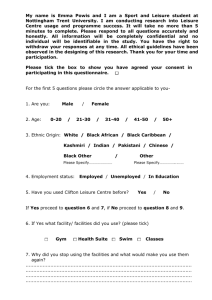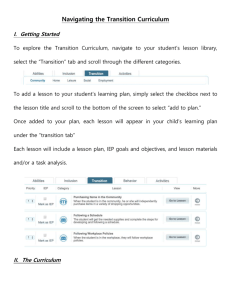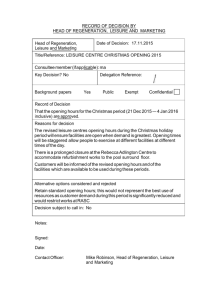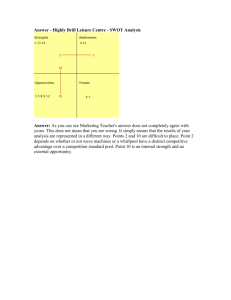Social group
advertisement
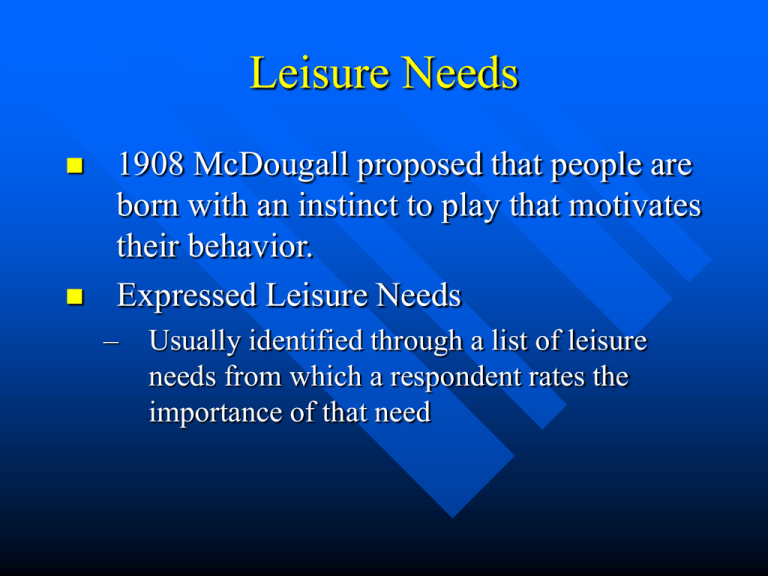
Leisure Needs 1908 McDougall proposed that people are born with an instinct to play that motivates their behavior. Expressed Leisure Needs – Usually identified through a list of leisure needs from which a respondent rates the importance of that need Levels of causality in Leisure Behavior Expressed Leisure Needs Perceived Freedom And competence Need for optimal Arousal and incongruity Biological Dispositions and Early socialization experiences So, what do we really know about motivations? Recreation Experience Preference Scale (REP) Paragraphs about Leisure (PAL) On, and on, and on!!! Iso-Ahola – Two basic motivational dimensions » Seeking and escaping Seeking/Escaping Based on Iso-Ahola’s model Personal satisfactions are mainly comprised of – Self-determination, sense of competence, challenge, learning, exploration and relaxation Both seeking and escaping motives are forms of intrinsic motivation Seeking/escaping dimensions of leisure motivation Seeking Personal Rewards Seeking Interpersonal Rewards Escaping Interpersonal Environments Escaping Personal Environments Psychological Antecedents: Need for stimulation Need for Autonym Social Environment (2) Cognitive Appraisal Of situational Risk (1) Attraction: Seeking and Coping with risk Declarative and Procedural Knowledge Objective/Subjective Risk Perceived Risk Previewed Competence Anticipation of Outcome (3) Decision making: Approach/withdrawal Positive Affect Self-Expression Centrality to Lifestyle (5) Intuitive-Reflective Appraisal Intense Task Involvement Cognitive and Affective Arousal Task Selection Risk Engagement (4) Performance Experience Satisfaction I can’t get no , satisfaction Appraisal and Evaluation Quality of Life – – – Morale, Happiness Satisfaction » With what? Satisfaction Happiness – Morale – Reflects a person’s more temporary affective feeling of the present moment More future-oriented optimism or pessimism with peoples lives Satisfaction – “an act of judgment, a comparison of what people have to what they think they deserve, expect, or may reasonably aspire to. Satisfaction A lot of satisfaction research focuses on the specific event (recreation) and is not necessarily tied to a leisure construct (theory) Consumer literature – – Service Quality (ServQual) Assesses how well an agency does what it says it does. Chapter 8 Pop Quiz 1. Think about a recreation activity that you do or have done 2. When, where and with whom did you start the activity 3. Who was the most influential person on your leisure behavior 4. Why did your family participate in the leisure behavior(s) that they did? Play Play: – – Intrinsically motivated behavior Freely chosen So why do we play? – Practice? » For later life Play Stages people go through Autoshpere: (birth to 2 years) – Microsphere: (2 to 4) – – The world of play that includes the body and what is immediately around it. Near environment “the world of manageable toys” During these two periods play is largely solitary Play Macrosphere: (4 to 7) – – – – Wider world of others (going beyond the self) Parallel play Associative play Symbolic & practice play 7-12 – Cooperative play Self-Socialization Seeking to become a greater part of the world around them. Children are “producers of their own development” How can this be facilitated (helped) – 1. leisure opportunities » – – Cognitive development, 2. Enjoyable activities and personally expressive activities 3. Social interaction Changing patterns through Childhood Erikson defined life stages for children Trust vs. mistrust (earliest stage) – – Autonomy (1 to 3) – Will this person come back and give me food? Will this person leave me in the dark? Being able to say no Initiative (3-4) Industry (above 4) – – Children begin to produce “Age in instruction” Leisure Orientations Socialization “into” and “through” leisure Socialization into leisure – “the process, by which children acquire motives, attitudes, values, and skills that affect their leisure choices, behavior and experiences throughout their lives” Socialization through leisure – Preparing children for their future social roles and responsibilities Leisure Influences Agents of influence: – Those entities that influence ones leisure behavior. Professionalized into sports? – What do children value in sports? » Younger » Fairness & Equality Older Winning Leisure Influences Family (parenting styles) – Authoritarian » It’s my way or the highway – Laissez faire » – Whatever! Democratic/authoritative The Harried Leisure Class – Linder Leisure Influences Children achieving flow (optimal experiences) – – – – – Feeling of choice and control Clarity of rules and structures Recognition of the value of centering or focusing attention Encouragement of commitment to task Creation of meaningful challenges. Leisure Influences How does culture influence the games that are played? – Structured and obedient » – Unpredictable » – Games of strategy Games of chance Conflict-enculturation hypothesis: » Games and activities both prepare children for their life in their culture and enable them to adjust and cope with conflict and stress resulting from child-rearing practices that essentially attempt to control and shape their lives. Leisure Influences Autotelic family context – A context where children learn to engage in activity for its own sake Peer influences on leisure – Relatedness is important for children » They want to belong to a social group Play training? – Emphasizing the importance of play through activities aimed at showing the benefits of play » Often for disadvantaged youth Leisure Influences Over programming children: – When we structure children's lives with so much stuff that they cannot be kids. Premature structuring – Making children performers before they are ready Media influences Positive vs. negative effects – – – – Glamorization of high adventure sports Gotta have mentality “Do the Dew” “If you have this, you will be it!” From childhood to adulthood Less than 50% of adult leisure activities are begun in childhood We develop a sense of self (identity) that may be different from our parents Individuation: – Process of adolescents defining themselves as unique and different from others However, children linked leisure with social interaction rather than being alone From childhood to adulthood Intensity of experience – – Being at a loud party, loud music Extremes with others confers a sense of belonging Deviation amplifying – – “You are the gas and I am the matches” Friends influence each other into doing things they normally wouldn’t From childhood to adulthood About 80% of people who enjoy outdoor activities in childhood actively enjoy outdoor activities in adulthood. Leisure Careers: – Enduring leisure pattern that develop into lifelong interests and commitments Leisure over the lifespan You can’t teach an old dog new tricks Do we continue to develop after adolescence? Influences on development? – – – Normative age-graded influences Normative history-graded influences Nonnormative life events Leisure over the lifespan Normative age-graded influences – – – Ontogenetic changes Specific to ages (stage theories) Predictable life events » » » High school Proms etc. Retirement Normative history-graded influences – – – Significant historical events Generation X Flower children (60’s) Leisure over the lifespan Nonnormative life events – – – Divorce Change in job Disability Changes in Leisure Participation Does age affect leisure participation? – – – How so? Are older folks likely to go skydiving? Are young folks likely to go square dancing? Leisure Repertoire (Iso-Ahola) Leisure Repertoire Birth Death Number of leisure activities available to Or participated in by the individual Childhood Early Adulthood Retirement Late Adulthood How do we study Leisure over the lifespan? Studying people Cross Sectional studies – – Studies that asses types and rates of participation across different segments of society, Can be segmented (sectioned) by » Age, rage, social class, geographic location (etc) How do we study Leisure over the lifespan? Longitudinal studies – Studies that asses types and rates of participation among the same group of people Cohorts – People that are grouped together based on some “criteria” » » Age is a common cohort Education levels Play Play: – – Intrinsically motivated behavior Freely chosen So why do we play? – Practice? » For later life Play Stages people go through Autoshpere: (birth to 2 years) – Microsphere: (2 to 4) – – The world of play that includes the body and what is immediately around it. Near environment “the world of manageable toys” During these two periods play is largely solitary Play Macrosphere: (4 to 7) – – – – Wider world of others (going beyond the self) Parallel play Associative play Symbolic & practice play 7-12 – Cooperative play Self-Socialization Seeking to become a greater part of the world around them. Children are “producers of their own development” How can this be facilitated (helped) – 1. leisure opportunities » – – Cognitive development, 2. Enjoyable activities and personally expressive activities 3. Social interaction Changing patterns through Childhood Erikson defined life stages for children Trust vs. mistrust (earliest stage) – – Autonomy (1 to 3) – Will this person come back and give me food? Will this person leave me in the dark? Being able to say no Initiative (3-4) Industry (above 4) – – Children begin to produce “Age in instruction” Leisure Orientations Socialization “into” and “through” leisure Socialization into leisure – “the process, by which children acquire motives, attitudes, values, and skills that affect their leisure choices, behavior and experiences throughout their lives” Socialization through leisure – Preparing children for their future social roles and responsibilities Leisure Influences Agents of influence: – Those entities that influence ones leisure behavior. Professionalized into sports? – What do children value in sports? » Younger » Fairness & Equality Older Winning Leisure Influences Family (parenting styles) – Authoritarian » It’s my way or the highway – Laissez faire » – Whatever! Democratic/authoritative The Harried Leisure Class – Linder Leisure Influences Children achieving flow (optimal experiences) – – – – – Feeling of choice and control Clarity of rules and structures Recognition of the value of centering or focusing attention Encouragement of commitment to task Creation of meaningful challenges. Leisure Influences How does culture influence the games that are played? – Structured and obedient » – Unpredictable » – Games of strategy Games of chance Conflict-enculturation hypothesis: » Games and activities both prepare children for their life in their culture and enable them to adjust and cope with conflict and stress resulting from child-rearing practices that essentially attempt to control and shape their lives. Leisure Influences Autotelic family context – A context where children learn to engage in activity for its own sake Peer influences on leisure – Relatedness is important for children » They want to belong to a social group Play training? – Emphasizing the importance of play through activities aimed at showing the benefits of play » Often for disadvantaged youth Leisure Influences Over programming children: – When we structure children's lives with so much stuff that they cannot be kids. Premature structuring – Making children performers before they are ready Media influences Positive vs. negative effects – – – – Glamorization of high adventure sports Gotta have mentality “Do the Dew” “If you have this, you will be it!” From childhood to adulthood Less than 50% of adult leisure activities are begun in childhood We develop a sense of self (identity) that may be different from our parents Individuation: – Process of adolescents defining themselves as unique and different from others However, children linked leisure with social interaction rather than being alone From childhood to adulthood Intensity of experience – – Being at a loud party, loud music Extremes with others confers a sense of belonging Deviation amplifying – – “You are the gas and I am the matches” Friends influence each other into doing things they normally wouldn’t From childhood to adulthood About 80% of people who enjoy outdoor activities in childhood actively enjoy outdoor activities in adulthood. Leisure Careers: – Enduring leisure pattern that develop into lifelong interests and commitments Leisure over the lifespan You can’t teach an old dog new tricks Do we continue to develop after adolescence? Influences on development? – – – Normative age-graded influences Normative history-graded influences Nonnormative life events Leisure over the lifespan Normative age-graded influences – – – Ontogenetic changes Specific to ages (stage theories) Predictable life events » » » High school Proms etc. Retirement Normative history-graded influences – – – Significant historical events Generation X Flower children (60’s) Leisure over the lifespan Nonnormative life events – – – Divorce Change in job Disability Changes in Leisure Participation Does age affect leisure participation? – – – How so? Are older folks likely to go skydiving? Are young folks likely to go square dancing? Leisure Repertoire (Iso-Ahola) Leisure Repertoire Birth Death Number of leisure activities available to Or participated in by the individual Childhood Early Adulthood Retirement Late Adulthood How do we study Leisure over the lifespan? Studying people Cross Sectional studies – – Studies that asses types and rates of participation across different segments of society, Can be segmented (sectioned) by » Age, rage, social class, geographic location (etc) How do we study Leisure over the lifespan? Longitudinal studies – Studies that asses types and rates of participation among the same group of people Cohorts – People that are grouped together based on some “criteria” » » Age is a common cohort Education levels Different types of leisure behavior Replacers (20%) – Quitters (25%) – Quit doing one activity and did not replace it with another Adders (16%) – Quit doing one activity that they had been doing for a while and replace it with another one Did not quit an activity but began a new one Continuers (40%) – Neither quit nor added activities Stages of Development Life Span vs. Life course models Life span models – Distinguish between stages based on psychological issues or challenges faced by individuals Life course models – Emphasize role-related changes that occur in contemporary society Stages of Development Retirement 60 40 Culmination of middle adulthood Settling Down Entering the Adult World 20 0 Early Adult Transition Mid-life Transition Late Adult Transition Leisure and Aging Activity Theory – People will be most happy and fulfilled in direct proportion to how much activity they are able to maintain Disengagement Theory – As the end of life draws near, people will voluntarily disengage fro mothers and from their former patterns, and societies withdrawal from them will leave them in peace and happiness Continuity Theory – Most successful aging is consistent with recognition of the need to establish ego integrity (people need to belong and have things to do that they feel are important) Chapter 10 Psychological Benefits of Leisure Benefit: – “a change that is viewed to be advantageous—an improvement in condition, or a gain to an individual, a group, to society, or to another entity” For it to be a leisure benefit two things must occur – – 1. involvement in some form of leisure is responsible for change 2. change must be an improvement over a previous state. Negative impacts of Leisure? Alcohol, Drug use – Pre coital/coital behavior – Alcoholism, drug dependency Teen pregnancy Depreciative behavior (tagging) Is all “leisure” necessarily beneficial? Leisure Benefits When studying leisure benefits, leisure is treated as a major input. Can look at – – – Setting Activity Experience Leisure Benefit Outcomes When talking about benefits, you have to address the outcome Leisure Inputs Production Process Outcomes Valuation Process Value or worth Benefits And costs Outcomes Psychological benefits – – Self actualization Stress relief Economic benefits Environmental outcomes Psychological Benefit Theories “Keeping Idle Hands Busy” – – People are most happy when they are busy Protestant Work Ethic » Idleness was considered and enemy of the soul – – Boredom has been studied extensively in leisure research What about keeping the idle mind busy? » Recharge my batteries » “get my head screwed on straight” » How do most people do this? Leisure Psychological Benefit Theories Psychological Hedonism: Pleasure-relaxationfun theories Hedonism: – Psychological theory that states that people will seek pleasure and avoid pain. Pleasure-relaxation-fun – People seek fun and although these experiences are relatively brief, they have a cumulative affect Psychological Benefit Theories Need-Compensation Theory – Leisure provides us a “benefit” we are not getting in other aspects of life (particularly work) Psychological Benefit Theories Personal Growth Theories – – – Self-esteem Self-actualization (Maslow stuff) Growing belief that leisure must be more than pleasurable, diversionary, or escape oriented? » Meaning it must be more than just an escape or fun! Idea of commitment, serious leisure, and flow » Belief that those who have higher life satisfaction are more involved in leisure behavior » Also known as high investment activities Psychological Benefit Theories Personal Growth Theories – In other words » “the more a person invests in the activities in which they choose to participate, the more they get out of the activity” » Leisure satisfaction vs. job satisfaction Psychological Benefit Theories Identity Formation and Affirmation Theory – People identify themselves by their leisure activities » Leisure can provide an opportunity to “experiment” Psychological Benefit Theories Identity Formation and Affirmation Theory – Leisure Identities » Express and affirm individual talents and capabilities » Provide some degree of social recognition » Affirm central values and interests – Some examples of leisure identities? » What about posers? Psychological Benefit Theories Buffer and Coping Theory Negative Life Events Increased Life Stress Leisure Buffer Maintained Worse Physical and Mental Health Psychological Benefit Theories Activity Substitution Theory of Aging – – – – As we get older, keeping active will help people adjust successfully to aging This can be done by substituting for activities that one cannot or is unable to do This “active” lifestyle adds to well being (psychologically and physically) Ullyssean adult Psychological Benefit Theories So what does it all mean? – – Research suggests that there are some benefits from leisure and sport participation (no kidding!) The theories tend to overlap CHAPTER 11 The Benefits of Leisure in Other Domains of Life Leisure as a Life Force Can the activities that people do for leisure help them enjoy their lives and deal with the challenges that they face in other areas of life? What do you think? Leisure vs. Non-Leisure Leisure is treated as the Dependent Variable – Because it is the area of life that is least constrained and more susceptible to other demands of life. (School, Work, Relationships, etc.) The Good, The Bad, and….. Positive Effects of Leisure on Work and Family: – Involvement in leisure can be a form of resistance against role constraints, thus leading to other changes in life. (think gender stereotypes) ….The Ugly. Negative Effects: – Leisure involvement can constrain men and women’s behavior in a variety of domains if they reinforce traditional views of masculine and femininity. Leisure and Life Satisfaction Life satisfaction is a popular measure of the quality of life. Life satisfaction scales measure enduring and stable beliefs and cognitions. Also looks at Global vs. Local Satisfaction and everything in between. Small but significant relationships have been found between frequent leisure participation and life satisfaction What do you think? What Supports That? Successful Aging & Life Satisfaction – Leisure activity levels may be better predictors of life satisfaction than health and income. – Measures of leisure satisfaction are better predictors of life satisfaction than actual participation. » The higher the leisure satisfaction = higher life satisfaction. » This link has been found to vary based on age, gender, ethnicity, occupation, and social status. The Case of Job Satisfaction Assumption that the job indicates activity selection, participation, and contacts. Spillover and Compensation Suggest that the nature of peoples’ work directly influences their choice of leisure activities. Spillover: Workers are thought to participate in leisure activities that have characteristics similar to their job related activities and tasks. Spillover & Compensation Continued… Compensation: Deprivations experienced at work are made up for during leisure people will satisfy needs that they cannot satisfy at work. There has been more support for spillover than compensation. Which do you agree with? Leisure Promoting Job Satisfaction The early classical theories of recreation and relaxation suggested that leisure is an important element in determining work satisfaction. Because of this many companies started to promote recreational programs for employees. “Leisure Buffing and Coping” Hypothesis “When work settling rules and expectations impede the satisfaction of important needs, leisure can provide opportunities for people to more readily meet those needs and affirm who they are.” (Kelly and Shamir) A.K.A: to compensate for psychological needs not met by work, achieve better life balance, and feel better about their work. Vacations. Do they promote job satisfaction or not? When workers find their vacations as highly satisfying then the majority find greater job satisfaction when they return. On the other hand job satisfaction decreased when workers had a less than satisfying vacations. A Further Look at Vacations 36 35.5 35 34.5 34 Low Satis. High Satis. 33.5 33 32.5 32 31.5 Prevacation Postvacation Time Measured Job Loss Through Retirement and Unemployment Leisure participation often changes as a result of these life events The right type of leisure may help people maintain their well being and cope or grow with these transitions. Job Loss Problems that arise – Loss of income – Social isolation (friends and coworkers) – Psychological losses (not contributing to society) Research suggest that the retirement transition is less traumatic and more satisfying among people with higher perceived levels of health and economic status; who have harmonious marriages and social support from their spouses and families. Job Loss Warr(1983) Identified nine potentially negative features of unemployment – Financial anxiety – Less variety in life due to reduced income and more time spent at home – Fewer goals or aims in life – Reduced opportunity for making important decisions – Reduced opportunities to exercise skills or expertise – Increase in psychologically threatening activities such as unsuccessful job searches – Insecurity about the future – Fewer social contacts – Reduced social status Job Loss Kilpatrick and Trew(1985) identified four groups on how unemployed people spent their “free” time – Passive group – Spent most of their time watching TV or doing nothing. – Domestic group – Spent most of their time at home, but unlike the first, assisted with household tasks. – Social group – Spent much of their time with people outside their immediate family – Active group – not only spent more time on workrelated activities, but also engaged more frequently in active leisure pursuits outside the home. Family, Friends, and Significant Others. “The central social space for the development and expression of primary relationships” – Kelly 1993 Some types of leisure are generally assumed to have positive outcomes for families. However, family leisure may lead to conflict and some family members may feel obligated to participate. Family, Friends, and Significant Others The benefits for family leisure can be divided into three major types – Family stability – Family interaction – Family satisfaction – (Orthner and Mancini 1991) Family, Friends, and Significant Others Family Stability – “The Family that plays together stays together” – It implies a continuity of interpersonal relationships in the family. Family Interaction – Refers to communication, conflict, and the distribution of household tasks and roles among family members. – Although it is mostly seen to enhance these features, family leisure can create conflict and destroy communication Family, Friends, and Significant Others Family Satisfaction – A consistent finding is that husbands and wives who share leisure time together in joint activities tend to be much more satisfied with their marriages than those who do not. – There tends to be a negative impact on marital satisfaction of frequent independent, individual activities by family members.



